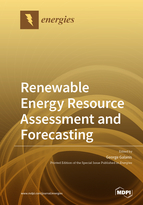Renewable Energy Resource Assessment and Forecasting
A special issue of Energies (ISSN 1996-1073). This special issue belongs to the section "A: Sustainable Energy".
Deadline for manuscript submissions: closed (31 May 2020) | Viewed by 43691
Special Issue Editor
Special Issue Information
Dear Colleagues,
The exploitation of renewable energy resources is nowadays a key issue worldwide and is on the top of the priorities list for governmental and private-sector organizations under increasing energy needs and warnings from the scientific community concerning environmental threads like global warming and climate change.
In recent decades, several projects have been launched that concern the development and use of new methodologies in order to assess, monitor, and support clean forms of energy. In this framework, the accurate estimation of the available energy potential is of primary importance but is not always easy to achieve due to the variable form and the complexity of the environmental conditions that are directly or indirectly involved.
The forthcoming Special Issue of Energies on Renewable Energy Resource Assessment and Forecasting aims to provide a holistic approach to the above issues by presenting multidisciplinary methodologies and tools that are able to support research projects and meet today’s technical, socio-economic, and decision-making needs.
In particular, research papers, reviews, and case studies on the following subjects are invited:
- Wind, wave, and solar energy resource assessment, monitoring, and forecasting
- Resource assessment of combined renewable energy forms
- Remote sensing for renewable energy assessment
- Numerical models for renewable energy forecasting
- Resource analysis tools and statistical models
- Renewable energy transformation and integration technologies
- Risk analysis and quantification of the uncertainty of renewables
- Extreme value analysis and forecasting for renewable energy resources
Prof. Dr. George Galanis
Guest Editor
Manuscript Submission Information
Manuscripts should be submitted online at www.mdpi.com by registering and logging in to this website. Once you are registered, click here to go to the submission form. Manuscripts can be submitted until the deadline. All submissions that pass pre-check are peer-reviewed. Accepted papers will be published continuously in the journal (as soon as accepted) and will be listed together on the special issue website. Research articles, review articles as well as short communications are invited. For planned papers, a title and short abstract (about 100 words) can be sent to the Editorial Office for announcement on this website.
Submitted manuscripts should not have been published previously, nor be under consideration for publication elsewhere (except conference proceedings papers). All manuscripts are thoroughly refereed through a single-blind peer-review process. A guide for authors and other relevant information for submission of manuscripts is available on the Instructions for Authors page. Energies is an international peer-reviewed open access semimonthly journal published by MDPI.
Please visit the Instructions for Authors page before submitting a manuscript. The Article Processing Charge (APC) for publication in this open access journal is 2600 CHF (Swiss Francs). Submitted papers should be well formatted and use good English. Authors may use MDPI's English editing service prior to publication or during author revisions.
Keywords
- wind, wave, solar, and combined energy resource assessment
- numerical modeling
- statistical modeling
- remote-sensing tools
- extreme values analysis
- risk analysis and uncertainty quantification






